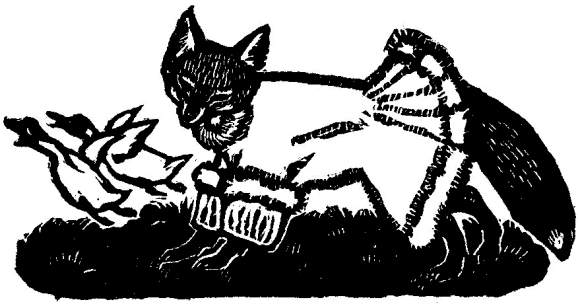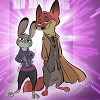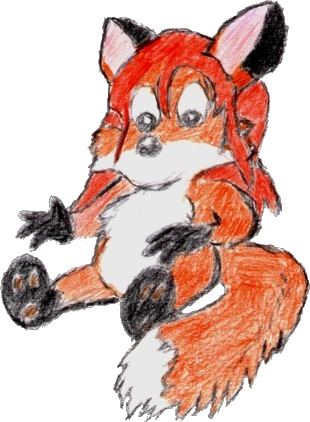A new sort of animal: 'Lady into Fox', by David Garnett
I don't feel the need to justify bringing up David "Bunny" Garnett's 1922 short novel Lady into Fox in a furry context. As the title suggests, the story involves a lady who turns into a fox. Technically, it is not a story about an anthropomorphic animal, and is in fact about the direct opposite of that, a zoomorphic human. Of course, this is a nitpick. I doubt anyone cares.

On the point of genre, however, there is one area where I would like to make a rather more controversial "take" on the subject matter. Though the novel was a bit unclassifiable when it was first introduced, with H.G. Wells (an author known for his use of anthropomorphic animals) praising it as "a new creation, a new sort of animal, let us say, suddenly running about in the world," a phrase that I imagine had him enthusiastically punching the air at his own cleverness.
More modern takes tend to classify it as a "contemporary fantasy". However, I find it to be entirely different: it seems nothing more (or less) than a tale of the supernatural; a ghost story whose 'ghost' merely requires a few scare quotes - or, put another way, a horror story.
Certainly, it contains very little in the way of the more garish elements usually found in the horror genre. There is little in the way of violence or gore. This is not a werewolf story where the 'wolf' happens to be a fox. Sylvia Tebrick, once transformed, does not tear across the English countryside, spreading fear and carnage – except, I suppose, for a few unfortunate rabbits. In fact, the final lines of the story are a simple assurance that the protagonist of the story, Mr. Tebrick, is still alive. But perhaps not well. It is a simple story about two people who encountered an inexplicable supernatural event one day, and were subsequently destroyed by it.
The novel begins by openly admitting there will be no explanation for the events that are to be described. They just happened. Nobody knows why. This opening feels distinctly like a modern non-fiction piece on an "unsolved mystery". In fact, it feels very much like the writings of Charles Fort could have been an inspiration. Fort's The Book of the Damned preceded Lady into Fox by just three years. Mrs. Tebrick's transformation would fit right in with Fortean lists of the 'damned', if it weren't fictional.
We're given a quick background of Sylvia Tebrick née Fox, which feels more journalistic than fictional, and her husband, Richard Tebrick, a gentleman of the English countryside during the Victorian period. It's noted that, yes, Mrs. Tebrick's maiden name was Fox, but if that had any bearing on the events or was just a coincidence, well, once again, nobody knows. Eventually we get to the actual transformation:
Before they gained the edge of the copse she suddenly snatched her hand away from his very violently and cried out, so that he instantly turned his head.
Where his wife had been the moment before was a small fox, of a very bright red. It looked at him very beseechingly, advanced towards him a pace or two, and he saw at once that his wife was looking at him from the animal's eyes.
That's it.
From here on out, there are no more supernatural elements. Nothing else magical happens. Sylvia Tebrick is now a fox, and her husband must deal with the fallout of this fact. One complication, however, is that though Sylvia's transformation was physically complete instantaneously, her mental transformation into a fox takes a bit longer. The story takes place over a period of about two years, and in the beginning, Sylvia insists on wearing clothes and enjoys playing cards. By the end of the story, she is a wild animal, with her own den, and all that goes with that.
The story, though narrated by Garnett (the author even namechecks himself in a brief anecdote), is mostly Mr. Tebrick's. The horror – if my thesis is correct; or at least tragedy, if it is not – comes from his reaction in watching the much slower mental transformation of his wife into something else. Personally, Sylvia's plight felt like a metaphor for slowly succumbing to a progressive neurodegenerative disease such as Alzheimer's, or a debilitating disease in general. (At least one pseudo-adaptation has turned the metaphor into one for drug addiction.)
Another possible take is that the story itself is a metaphor for marriage itself. Mr. and Mrs. Tebrick are newlyweds when the incident occurs, and the opening implies their courtship was brief. Though Mr. Tebrick is steadfastly loyal to his wife, in whatever form she takes, there's a subtle implication that he's in love with a idealized version of her, not the actual flesh and blood creature before him.
Eventually, Mr. Tebrick allows his vixen wife to escape into the wild, where she eventually finds a dog fox mate, and births a litter of kits. Again, there is something just a little bit unnerving about Mr. Tebrick grappling with the idea that he's literally been cucked by a wild animal, if also darkly humorous. The novel openly acknowledges that, from the outside perspective, much of the incidents related can be funny or downright adorable (Sylvia as a fox merrily chasing ducks in a cute little dress, for instance, a scene illustrating the cover in a woodcut by Rachel "Ray" Garnett, David Garnett's first wife, who also illustrated Book of the Bear); but also reminds us that, from Mr. Tebrick's perspective, this is all deadly serious.
There doesn't seem to be much evidence that David Garnett, or his book, had much influence on our furry subculture, though it seems he would fit right in. His follow up novel was A Man in the Zoo, which featured a man volunteering to represent the animal known as Homo sapiens at a zoo. The thin line between animals and humans was a recurring theme. Furthermore, he was a bisexual man known as "Bunnie", and even specifically referred to himself as a rabbit in the title of one of his nonfiction books. Of course, the main reason that Garnett or his novel had limited to no real influence on the furry subculture is the simple fact that it was out of print during the formative years of the fandom, only recently coming back into print (though, as it is now public domain, this is perhaps a bit beside the point).
Contemporary writer H.P. Lovecraft wrote in his influential essay
We may say, as a general thing, that a weird story whose intent is to teach or produce a social effect, or one in which the the horrors are finally explained away by natural means, is not a genuine tale of cosmic fear; but it remains a fact that such narratives often possess, in isolated sections, atmospheric touches which fulfill every condition of true supernatural horror-literature. Therefore we must judge a weird tale not by the author's intent, or by the mere mechanics of the plot; but by the emotional level which it attains at its least mundane point. If the proper sensations are excited, such a "high spot" must be admitted on its own merits as weird literature, no matter how prosaically it is later dragged down. The one test of the really weird is simply this - whether or not there be excited in the reader a profound sense of dread, and of contact with unknown spheres and powers; a subtle attitude of awed listening, as if for the beating of black wings or the scratching of outside shapes and entities on the known universe's utmost rim.
Lady into Fox does not offer explanations, and Garnett has said that if offers no moral. But does it pass Lovecraft's "test of the really weird"? Can you hear, in the oddly specific words of an author often critiqued for his vagueness, the "beating of black wings" in Lady into Fox? The twentieth century's other dark titan of horror literature, Stephen King, wrote in his nonfiction book on the subject of horror, Danse Macabre:
If you're a genuine horror fan, you develop the same sort of sophistication that a follower of the ballet develops; you get a feeling for the depth and texture of the genre. Your ear develops with your eye, and the sound of quality always comes through to the keen ear. There is fine Waterford crystal, which rings delicately when struck, no matter how thick and chunky it may look ...
That delicate ring of the real stuff is there, it can be perceived ... and the heart responds.
If I may be so bold, I believe I can hear this "delicate ring" throughout Lady into Fox. In "high spots" such as Mr. Tebrick crawling into his beloved dog's kennel with a loaded gun, his second encounter with the dog fox who has become his wife's mate, or just the simple, insane image of him baptizing five little fox cubs in the woods, yes, something is scratching there.

About the author
2cross2affliction (Brendan Kachel) — read stories — contact (login required)a red fox
New teeth. That's weird.

Comments
This says much about how we receive things as humans. The weird factor in particular; stories with similar abandon regarding social constructs, like Prelude To A Kiss or Harold & Maude, would probably get more brilliance tags than Lady Into Fox, and mostly for superficial reasons.
StratoKasta
Lady into Fox was adapted to ballet in 1939 by choreographer Andrée Howard. The original fox costume, by Nadia Benois, was made out of "terry towelling with hand-knitted tights" according to the Guardian - which covered a 2006 revival by Mark Baldwin, with Michael Howell using feathers for the costume, for which a photo is found in a later piece (and here; search "Lady into Fox"). Apparently the work conveyed "a gentleness and restraint, and an emotional and psychologically subtlety long gone from the pier-end gymnastics that pass for modern choreography" - at least in its 2012 edition. Perhaps by then "the joins between Baldwin's adroit invention and Howard's more old-fashioned rhetoric" were less "intrusively evident".
Post new comment